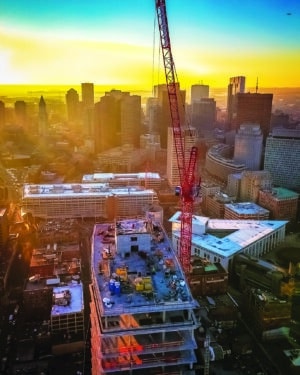
Hub50House under construction near Boston’s North Station. Changing political winds in the city are leaving the future of development in the city uncertain.
It’s too early to call an end to Boston’s epic building boom, which got cranking in the late 1990s and really never stopped.
But it’s pretty clear that construction of everything from new residential and office towers to big, new lab projects hit peaks during the tenure of now former Mayor Marty Walsh that they are unlikely to reach again, at least in the foreseeable future.
And that’s the case whoever happens to win the mayoral race this fall, because there’s really no place to go from here but down, at least when it comes to the sheer volume of construction.
While the mayoral contest is still very much in the air, no one in the race, except former economic development chief John Barros, seems particularly interested in picking up Walsh’s mantle as builder-in-chief.
And Barros’s campaign is the longest of long shots at this point, with the guy who negotiated the GE headquarters deal polling abysmally and fighting to simply be included in televised debates.
Yet it’s hard to imagine anyone coming close to touching the former mayor’s record when it comes to the sheer volume to new projects given the green light over the past seven years.
Walsh’s Legacy: 105M SF
Walsh’s record stands out, likely even beating that of development-friendly predecessors in the mayor’s office like the late, great Thomas M. Menino or Kevin White.
Just ask Brian Golden, director of the Boston Planning & Development Agency who was Walsh’s right-hand man on big projects.
City Hall’s development arm issued permits for more than 105 million square feet of new office, residential, retail and lab space during Walsh’s seven years in office.
That’s an average of 10 or 11 million square feet getting the nod every year from city planners – or enough to fill that many new Prudential tower every 12 months.
“It’s the biggest period of building permitting in [Boston] history,” Golden noted during an interview the other day. “There has never been a seven-year period where that much has been permitted.”
It’s a case of a man meeting the moment, and the moment meeting the man.
Walsh took over a city in 2014 that that was already in the midst of a years-long building boom, with Menino, the city’s longest-serving mayor, having presided over a rebirth in residential construction.
Live-and-Let-Live Opened Floodgates
Walsh came to the job having risen through the ranks to become the head of the city’s construction trade unions, after getting his start as a rank-and-file laborer.
Amazingly, one story line in the local media during that 2013 race was whether Walsh, as a union boss, might be somehow hostile to business.
Only someone completely unfamiliar with the central role that development plays in local politics – and unfamiliar with how local construction trade unions operate – could push such a completely clueless story.
In terms of background, a history in the construction trade unions is about as pro-new development as you can get, short of being a developer yourself. That experience will give you a unique perspective on the importance of new projects in creating decent union jobs and keep the city’s tax coffers full.
Walsh also skipped the grudge-fests his predecessor waged against builders who he took a disliking to – and there were quite a few. In and of itself, this more live-and-let-live approach resulted in fewer projects stalled due to behind-the-scenes political power games.
Wait-and-See Until Nov. 2
So, looking ahead, what can we say of the likely development policies of the candidates vying to become the city’s next mayor?
So far, not much, other than to say things are going to be different.
In a telling move, Acting Mayor Kim Janey recently pulled the plug on waterfront zoning that would have paved the way for Don Chiofaro’s proposed 600-foot tower to take shape next to the New England Aquarium.
The move came after pressure from environmental groups, two towers’ worth of waterfront condominium owners and fellow candidates.
Chiofaro’s tower plans went nowhere under Menino after the outspoken and colorful developer clashed with the mayor, only to see his project resurrected during Walsh’s more tolerant years.

Scott Van Voorhis
Things also promise to change if City Councilor Michelle Wu, a top-tier candidate, manages to get across the finish line this fall.
She would likely bring a more analytical and probing approach when it comes to the pros and cons of new projects.
A long-time critic of the BPDA, Wu has proposed splitting City Hall’s development arm in two, something that certainly has the potential to slow down the pace of new project approvals – if she can ever get the idea through Beacon Hill
We’ll just have to wait and see who wins and what approach they will take to developers with ambitious plans.
But the days of city officials waiving through 10 million square feet of new development each year are over.
The only question is whether we will be looking at a nice and easy glide down from record heights of construction activity, or a hard landing.
Scott Van Voorhis is Banker & Tradesman’s columnist; opinions expressed are his own. He may be reached at sbvanvoorhis@hotmail.com.




 |
| 